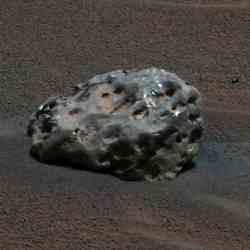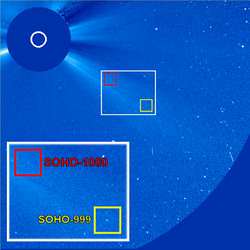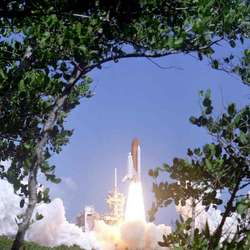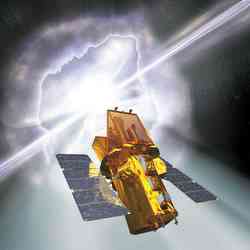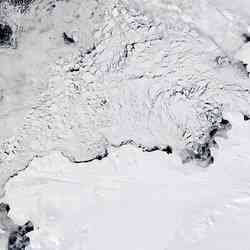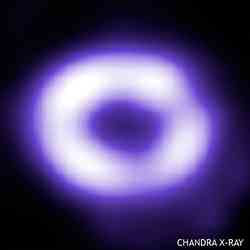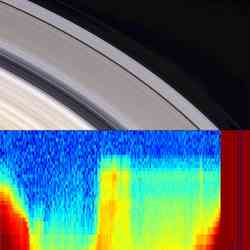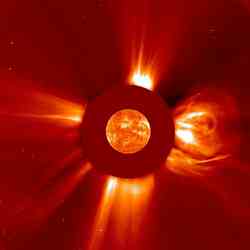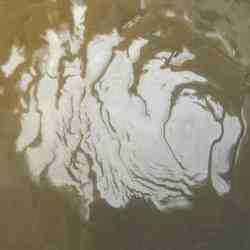
Mars south polar cap. Image credit: NASA/JPL/MSSS Click to enlarge
Pamela Conrad, an astrobiologist with NASA’s Jet Propulsion Laboratory, has traveled to the ends of the Earth to study life. Conrad recently appeared in James Cameron’s 3-D documentary “Aliens of the Deep,” where she and several other scientists investigated strange creatures that inhabit the ocean floor.
On June 16, 2005, Conrad gave a lecture called, “A Bipolar Year: What We Can Learn About Looking for Life on Other Planets By Working in Cold Deserts.”
In part 2 of this edited transcript, Conrad describes how her work in cold deserts could aid the search for alien life.
“If we were to find life on Mars, and that life lived in the rocks, how would we study it? You can’t answer that question unless you first do some experiments on Earth. And that’s what we’re doing in the Arctic and in the Antarctic.
In the Arctic we looked at a volcano about a 150 to 200 thousand years old, made of weathered basalt. It’s very interesting weathered basalt, because it contains minerals that look very much like some of the unexplainable minerals in the controversial martian meteorite that was described to have fossilized life in it.
In the Arctic site that we went to — Svalbard, Norway — there are polar bears. So when you go to the Arctic, you have to have some training in shooting. They don’t want you to kill polar bears, but they want you to be able to do so if he’s about to kill you. So we started our expedition to the Arctic with a half-day of gun training. It was fun shooting at paper targets, but I don’t know what I’d do if I were confronted with a polar bear looking at me with dinner in his eyes.
There are no polar bears in the Antarctic, but the sea life is abundant and diverse. At McMurdo Base, there are penguins, there are birds called skua, there are a couple of different types of seals. As you go farther away from the base by the shore, you get to places that are desolate. We investigated a place in the McMurdo Dry Valleys called Battleship Promontory. The rocks there are sandstone, and they were originally deposited underwater. Inside these rocks, thriving layered communities of microbes make their existence. They freeze solid during the winter and come back to life during the summer. Of course, the summer at its most exuberant heat wave only gets to be about 10 degrees Centigrade.
NASA’s strategy for looking for life is to first look around quickly, and process a lot of information. When you get to the interesting stuff, you might take a longer amount of time, and do it more carefully with higher resolution. You wouldn’t want to do something really destructive first, because you might destroy the thing you’re trying to study. You want to be as minimally invasive as possible. Some techniques are very invasive: taking a hammer and whacking on a rock and breaking it into pieces certainly makes you unable to look at the basic overall structure, the geomorphology, of that rock. So when you’re looking for life in rock, if you’re trying to be non-destructive, you can’t crack open the rock and look inside. So there has to be some kind of clue of life on the surface of the rock.
Porphyrins are a ubiquitous class of naturally occurring compounds with many important biological representatives including hemes, chlorophylls, and several others. Life anywhere is going to have some sort of electron transport or energy harnessing system. The common ones on Earth are based on porphyrins, which have very specific shapes.
We would like to bring samples back from places like Mars, but right now we don’t know how to do that. In the future, we will do that, but then it would be a very long experiment. We have to develop the technology to do it, we have to get to Mars safely, we have to get the samples, and we have to safely get it back. That’s a complex problem.
Eventually, there will be human exploration. I want to go to every cool place I can, but I don’t think I’ll go to Mars anytime soon. But there are a lot of people who want to go to other planets, and as we listen to the different strategies and paths that NASA takes, I’m sure that that will happen in time. Right now, I’m focussing on things that might prepare us for the type of solar system exploration that we’re doing right now: sending out a spacecraft, landing it, and doing an experiment.
So my team is developing strategies for life detection, using methods that are non-destructive and quick. We survey the landscape with a minimally invasive tool, we look for the contrast in the chemistry of the rock and the chemistry of organisms that might be on or in the rock. We do it in cold deserts because cold deserts are analogous to the kind of environment we find on Mars. Mars is much drier and much colder, but that’s about as close as we can get here.
My group has been working with an optical technique. I like to describe it as the black light you can buy at PetCo, where you shine the light on the carpet to look for dog or cat pee. Only ours is a little bit higher tech and more specific than that, because there isn’t any dog or cat pee in the areas where we go. Our technique is called “laser-induced native fluorescence.” You take a very short wavelength of light – an invisible wavelength deep into the ultraviolet – and you illuminate a spot. If that spot has organic molecules, that spot glows. And the color of the glow tells you something about what kind of molecule it is, how big it is, how complicated it is. And it’s really cool because it’s fast – you can do this in 50 microseconds. Even though ultraviolet light can be damaging, we have a very short blast. So this is a very minimally invasive technique, because it doesn’t harm living things. The microbes that we’ve detected using this method don’t die.
The machine is about the size of a shoebox, and you can take it anywhere you want to immediately tell where you have life and where you don’t.
We’ve used this tool in the Arctic, sticking it into holes to determine whether or not certain minerals have any organic molecules associated with them – the specific organic molecules that might be associated with the presence of microbes. That tells us whether to grab any rocks and take them back to the lab to look for organisms. We’ve also used the tool on a manipulator arm of a deep-sea submersible and detected organic molecules coming out of hydrothermal vents on the sea floor.
In Antarctica, the organisms live in a certain type of rock that has a lot of pore space to hold water. That means they’re better able to maintain hydration. Temperatures in the rock swing, but not as wildly as the outside air because of heat that’s absorbed by the rock during the day. Also, the kind of minerals that make up that rock are transparent to ultraviolet light. If the basis of your food chain is photosynthesis, then you’ve got be underneath a mineral that transmits light.
There are different kinds of organisms that live in the rock. The kind of organism that lives in the pores spaces of rock don’t go very deep — maybe a centimeter and a half if you have a really thick community. But you do see chemical evidence going a few centimeters deeper into the rock.
There are other kinds of organisms that don’t live in the pore spaces. They migrate into the cracks in rocks. They are called “chasmoliths.” They typically do chemosynthesis, that is, they rip out chemistry associated with the rock, and they either oxidize some ion, or reduce some other ion, and this whole cycle of oxidizing something and reducing something is akin to the respiration we do. Since it doesn’t involve photosynthesis, they don’t need light, so they can go deeper into the rock. But the chemistry in the rock influences how deeply they can go — these tiny organisms have a community structure that has a specific set of chemical conditions that support it. If you change that set of chemical conditions, you have a whole different environment. Another limitation is you can’t go too deep and use up too much space, or thermodynamically you can’t continue to do chemistry because you’ll drown in your own poop. That’s an unfortunate state of affairs.
You can tell the difference between one bacterium and another with our instrument, because different chemicals are on the surface of the organisms. Just using fluorescence can tell you the difference between basic types of bacteria. If you have a spore, and you want know what species you have, you use other techniques, like looking at the vibrational properties of the atomic bond.
One of the cool things about looking for microbial life on Earth is that microbes are everywhere. Most of the biodiversity on Earth is microbial, and they can live in challenging environments. You have to give them credit for being clever in terms of coming up with adaptive strategies to cope with stressful environments.
When we think of looking for fossils of past life, we tend to think of stuff like dinosaur bones. Astrobiologists don’t really expect to find dinosaurs on Mars, although I do have a National Enquirer cover that differs.
But you can find fossil structures in rocks, created from organisms that were in the sediment as it was being lithified – made into a rock. You can also try to find chemical fossils, signs that there was life there. There are some chemicals that are really big molecules that are very hardy and withstand a lot. We just have to be clever enough to distinguish the chemistry associated with the rock from the chemistry associated with the living things.”
Original Source: NASA Astrobiology

